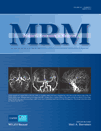Small-tip fast recovery imaging using non-slice-selective tailored tip-up pulses and radiofrequency-spoiling
Abstract
Small-tip fast recovery (STFR) imaging is a new steady-state imaging sequence that is a potential alternative to balanced steady-state free precession. Under ideal imaging conditions, STFR may provide comparable signal-to-noise ratio and image contrast as balanced steady-state free precession, but without signal variations due to resonance offset. STFR relies on a tailored “tip-up,” or “fast recovery,” radiofrequency pulse to align the spins with the longitudinal axis after each data readout segment. The design of the tip-up pulse is based on the acquisition of a separate off-resonance (B0) map. Unfortunately, the design of fast (a few ms) slice- or slab-selective radiofrequency pulses that accurately tailor the excitation pattern to the local B0 inhomogeneity over the entire imaging volume remains a challenging and unsolved problem. We introduce a novel implementation of STFR imaging based on “non-slice-selective” tip-up pulses, which simplifies the radiofrequency pulse design problem significantly. Out-of-slice magnetization pathways are suppressed using radiofrequency-spoiling. Brain images obtained with this technique show excellent gray/white matter contrast, and point to the possibility of rapid steady-state T2/T1-weighted imaging with intrinsic suppression of cerebrospinal fluid, through-plane vessel signal, and off-resonance artifacts. In the future, we expect STFR imaging to benefit significantly from parallel excitation hardware and high-order gradient shim systems. Magn Reson Med, 2013. © 2012 Wiley Periodicals, Inc.




